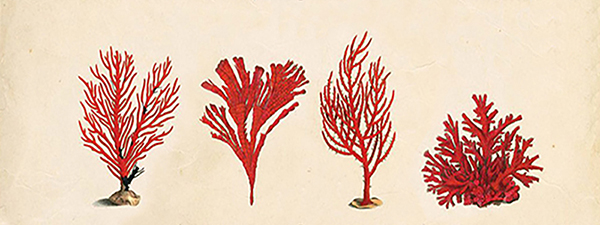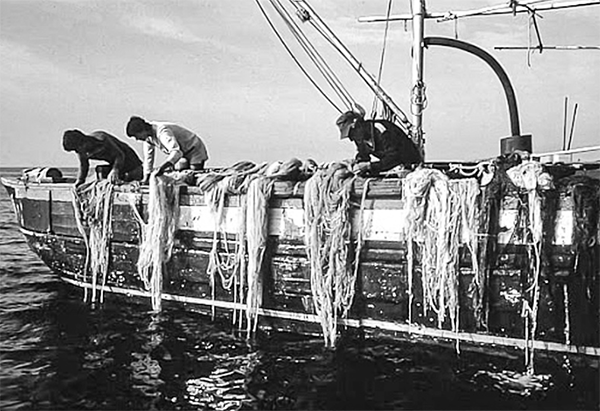|
|
Legend says that coral is blood of mythological medusa Gorgon, that one with a mass of snakes instead of hair which, torn from the seabed and brought to the surface, hardened turning into rigid branches. In fact, Calvino cites, translating Ovidiu’s Metamorphosis: «So that the rough sand does not spoil the snake head (with snakes instead of hair), (Perseus) softens the ground with a layer of leaves, spreads underwater twigs on it and places Medusa's head face down ... The more unexpected thing is the following miracle: the underwater twigs in contact with Medusa transform into corals, and the nymphs rush to adorn themselves with corals and bring twigs and algae close to the terrible head». So, it was believed that red coral, soft in water, could harden at the touch, and that it was needed a special metal tool (Kourà) to collect it. This belief was probably favored by the confusion that ancient people had between red coral, of solid consistence but slimy, and gorgonians which have a flexible consistence instead. Notwithstanding that coral in the archaic Greek world was very rare, there is no doubt that it was regularly collected and was also used in jewelry, as well as exported and marketed. Clear traces of the use of coral are found even more in the Phoenician-Punic and Celtic world (where there is a coral Symbolon) and especially in southern Italy, while at the present state of knowledge it seems to be practically absent among the Etruscans, almost disappeared in the Roman Imperial age. This last strange absence conflicts with the sources of that time, which often mention coral for naturalistic and ornamental purposes. This apparently low interest of Romans towards coral can be explained by searching its cause in the total export of the Mediterranean production to the Indian market, where it was extremely appreciated and it could be equally exchanged, with pearls; one grain of coral was worth one pearl. To be frank, also in the previous age rarities of Mediterranean origin area (Sardinia and Africa) were justify motivating it with a massive export toward Celtic zones; however, when we go and search for real traces of Roman coral, mentioned in the few texts such as Alasandraka (Alessandrino), we realize that there are very few confirmations. In fact, to date the question of coral fishing in the Mediterranean Sea continues to propose very suggestive hypotheses which, however, are struggling to find real concrete confirmation. Lately, an important contribution was given to this research from diving archaeologists who, during some excavation campaigns on ancient shipwrecks have detected the presence of loads of this kind. Effectively, a testimony to this direction was found on a wreck dating back to the end of the fourth century a.c. found in Mallorca, where a load with a strong Phoenician-Punic component has returned different clean red coral. Another important validation was found in one of the Greek-archaic ships discovered in Marsiglia port, surely used for coral fishing since the fragments found were congealed in the internal flaking of the hull. After careful and detailed exams, the result achieved is that they cannot be part of port sediments, but that they ended up in softened pitch during sea fishing under the scorching Mediterranean sun. This essential discovery testifies to the practice of coral harvesting at the end of the sixth century a.c. in one of the most important areas indicated by Pliny in his Natural History. The constant finding of coral in several shipwrecks is an event clue of the exchange among Mediterranean population. Diving archaeology research clarifies about the tools used and the location of banks exploited, already destined to reach exhaustion very soon, forcing to find new fruit-bearing areas. By comparing some texts of two different authors almost contemporary of the first century d.c., these reveal several differences about the information of places to collect coral. The attention of the botanic doctor Dioscuride concentrates in the Sicily channel and limits by mentioning Pachino near Syracuse, place of one of the most ancient and important fisheries in Sicily, surely also engaged in coral works, as fragments present in the fissures of the fishery floor demonstrate. From more recent sources the naturalist Plinio, besides mentioning Sicilian and Gallic coral (in the Eolian islands and Trapani), indicates the increase of fish centers including Red Sea and Persian Gulf, very important places not only for a darker coral type called Lace, but also because they were situated on the trading route with India, a market that, as we said, demanded huge quantities of red coral of the Mediterranean Sea.
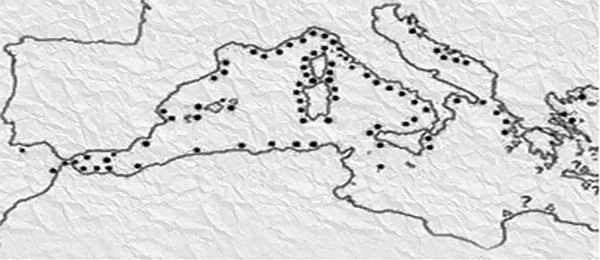 |
|
Pic. 1 – Reproduction of a map indicating the areas of red coral fish in the Mediterranean Sea used in the old time |
Besides several and absurd ancient explanations of the term «coral», Plinio proposed one which refers to the tool used to « sweeping the dark sea and the unhappy shore » (Eschilo): the koura from which ”coral”. Also, if an epigraph found in Malta translated from the abbot Fourmont showing a Jupiter Urinator revealed to be false in the XVIII century, it is a common opinion that during the Roman Empire the Urinatores, which we can be defined as a corporation of professional divers collected coral also at a depth of 20-25 meters or in caves by means of a sharpened tool (Aut Acri Ferramento Praecidi).
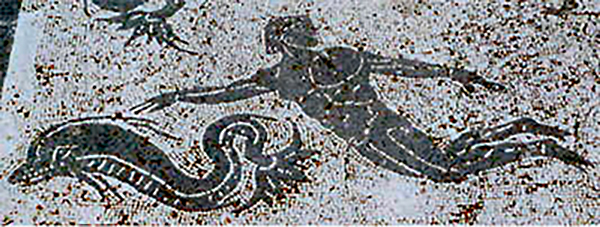 |
|
Pic. 2 – Mosaic representing a Roman swimmer called Urinator |
Urinatores did not use any mask and for this reason they had an unclear sight of the sea bottom, so that they often teared down red gorgonian instead of coral. From this misunderstanding, the old belief of coral petrification results; in fact, for Plinio the soft gorgonian was coral. The entire story of the systems to fish coral has more shadows than light; yet more and more frequent research reconducts to some finds of difficult interpretation, such as in the case of a lead artifact with an unusual shape found in Cefalù (pic. 3). Another example is a special stone, initially considered an anchor, while later was seen differently and connected to the coral fish (pic. 4).
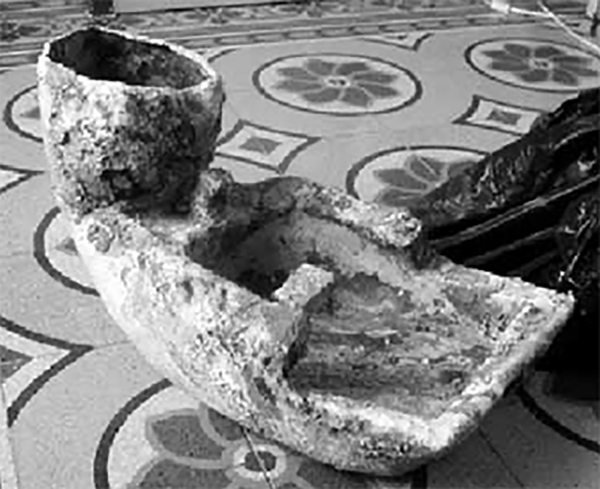 |
|
Pic. 3 – Lead artifact of Cefalù |
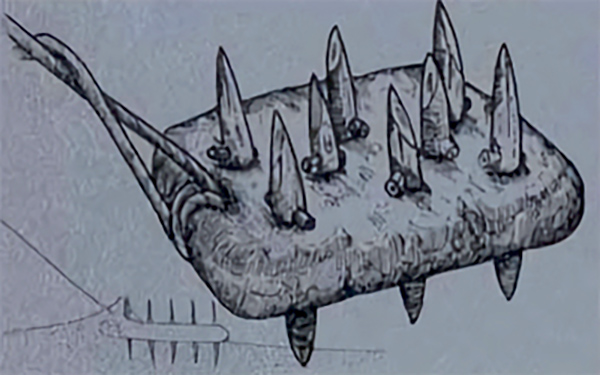 |
|
Pic. 4 – Lengthily confused as a lithic anchor, this drilled stone was certainly a tool to collect coral |
Another example is a stone presented as a Phoenician-Punic anchor (pic. 5). The prevailed opinion was to interpret the unusual find as the ballast stone of St. Andrew’s wooden cross (pic. 6), a tool that has been used to fish coral almost until now. The iron and lead rings, sometimes found together with this stone were considered suspension rings for nets connected to it. It seems that the stone was fixed in the cross lower part, while the tool was weighted in its upper part with a lead ballast (pic. 7). This instrument simplicity has induced to date its use back to ancient times, and to presume that a kind of lead ballast with holes (pic. 8) was necessary to fix the beams of a wooden cross to fish coral.
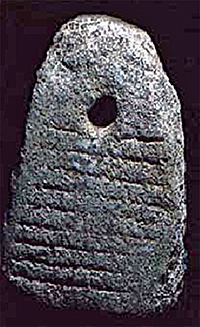 |
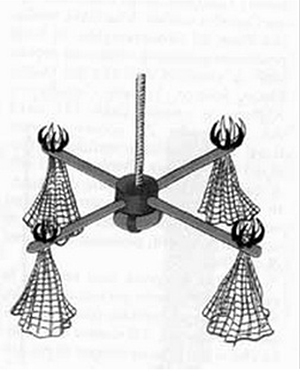 |
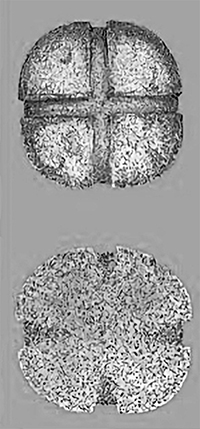 |
| Pic. 5 – Ballast for St. Andrew's cross | Pic. 6 - St. Andrew's cross | Pic. 7 - Lead ballast |
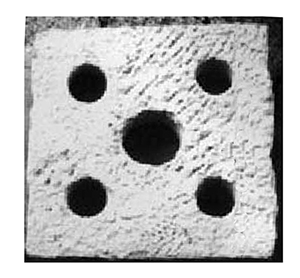 |
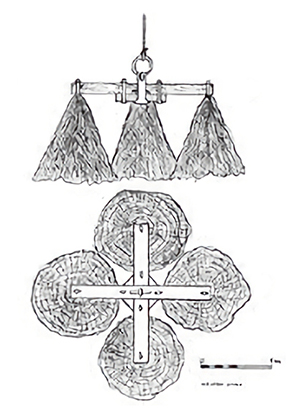 |
| Pic. 8a – Lead ballast with 5 holes | Pic. 8b – Use of lead ballast with 5 holes |
If there are some doubts about tools used in the different collecting areas, we are certain that coral was fished from the archaic age to the fall of the Western Roman Empire (476 d.c.).
Occasionally, in some places it was also carved; this should lead us to think that there were also some problems raising by this activity, with the need to regulate it with appropriate rules: discipline of fish zones, relationship between ship owners and fishermen, development of companies to finance this business, forms of co-participation to profits, relationships with merchants and wholesalers, privileges, and exemptions. If for the ancient age we have no certainties, in the modern age shadows quickly dissolve, dating to years 1628-1633 the compilation of the coral code of the city of Trapani. This is the first traced rule to regulate all problems related to activities linked to coral.
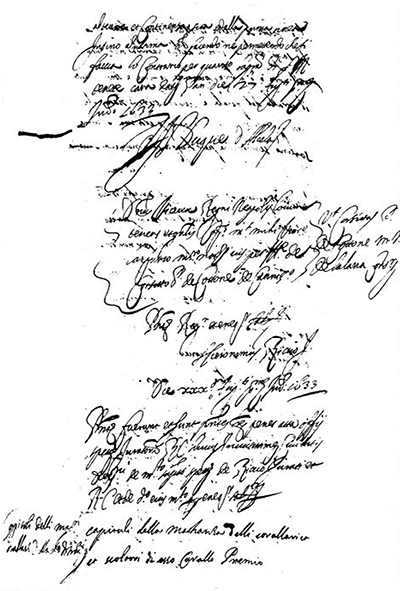 |
Considering that the code made in Trapani set a certain order in the environment of coral fishermen, this did not avoid that in 1672 - 1673 a revolt arose because of the usual problems related to the exploitation of fishing grounds. Another fundamental step to try to rule coral fish is the issue of the coral code in 1790 from Ferdinand IV of Borbone, to safeguard coral fish and manufacturing in the one that will become the Kingdome of Two Sicilies in 1816.
Equipment and devices
Systems for coral fish did not change much since the ancient age to our more recent times; in fact, tools such as Saint Andrew’s cross, the Italian board and others will be used in the Mediterranean Sea until when they will not be banned at the end of the XXth century. These tools, most of the time coming from Livorno and Marsiglia, were for the most part built with ballasts or rakes to break coral, combined with containers, nets or cotton bags to recover it. Their functioning was very easy. Once lowered the tool linked to a long rope rolled up in the boat bottom, fishermen waited until it touched the sea bottom. Then, they proceed to recover branches and fragments which got caught in the nets. This system, prevalent in rowing boats equipped with 6-8 people, was mostly used near the cost and it was of common use until engine came; later, people recurred to larger and powerful boats, able to fish in higher depths, with bigger devices, actuating real disasters in the sea bottoms.
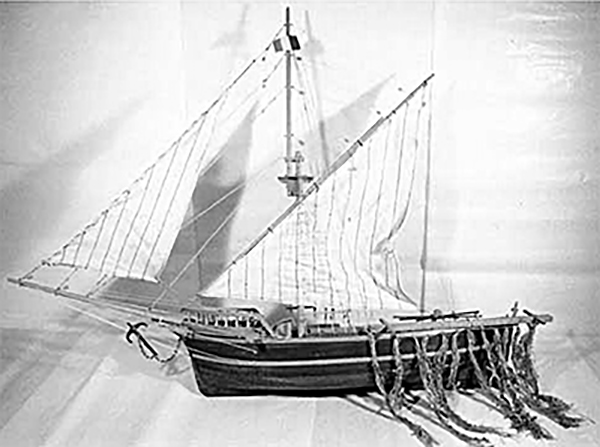 |
|
Pic. 10 – Classic coral boat |
From prehistoric to classic age, coral was simply collected at the water edge, when it was brought from coastal storms, or found in the fishing nets if accidentally caught in them. We do not know about the fishing system used for more than half millennium after the end of the Roman Empire. We only know that in an uncertain moment of the Middle Age, probably during the Islamic expansion in the Mediterranean Sea, Saint Andrew’s cross began to be commonly used, a tool that is probably of Arab matrix, used in different versions almost until today. It was made of two crossed wooden beams of different lengths, equipped with a lithic ballast in its intersection, subsequently substituted with a lead one, held by a robust rope connected to the boat. At the beam extremities the “Retazze” were fixed, some pieces of net hanging in a bow, or bag or free, with a length of 7-8 meters. Its use was simple; sailors with adequate maneuvers from above made the tool that broke the coral branches crawl along the rocks, and then get entangled in the pieces of net. As we said, there were different versions of this device, depending on the age, of the fishing place, of the fleet and the morphological characteristics of the bottom: variable cross, Greek cross, Lorena cross, with long axe, with ballasts and nets also along its arms, with short and long beams (also several meters). To conclude, small and large devices, operated by few of several fishermen, both manually or by winch, on boats of different dimensions called Coralline. Together with these crosses, in the late Renaissance other types of devices appeared, with a more limited luck in time and space. They were the Salabra or Salabre, mainly used in Provence and Spain and the more recent Italian Board, suitable for a systematic fish at higher depths. Unfortunately, in the last 500 years the indiscriminate use of a demolition system such as these devices has caused very serious damage to the marine habitat. So much so that in 1989 an Italian law banned its use, followed in 1994 by a European Community directive which prohibited it in all countries of the old Continent. Since then, coral fish became an exclusive prerogative of authorized divers, with strict rules and limitations. But this is another story.
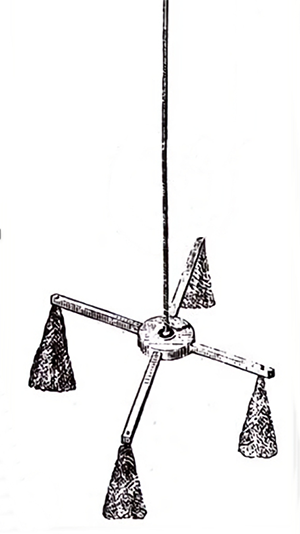 |
Pic. 11 – INGEGNO (DEVICE) WITH CROSS OR SAINT ANDREW’S CROSS – It was made with two big hard wooden beams (Coscioni), 70 cm. long or more, fixed as a cross. In their intersection, a heavy ballast was positioned while at the extremity of each beam some nets were fixed, with large mesh, hanging with small or large bows.
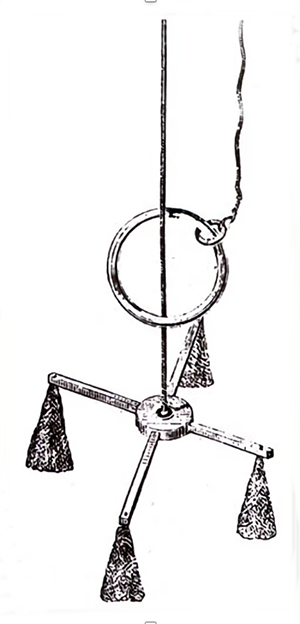 |
PIC. 12 – TORTA (CAKE) OR TORTOLO. It was an iron ring weighting approx. 80 kg. for vessels of 15/20 tons and only 20/30 kg. for smaller boats. It was used to free the device when it got stranded in the rocks, by making it run along the cable to cause it to fall violently, thus freeing the tool.
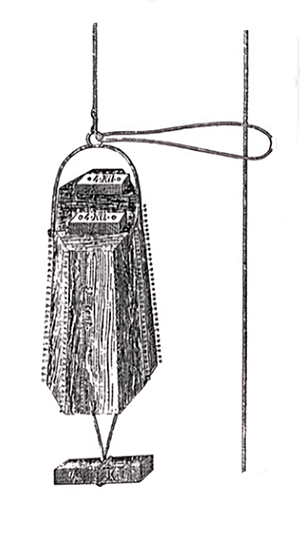 |
PIC. 13 - SBIRO. It was an octagonal wooden piece, 80 cm. long for larger boats or 50 cm. for smaller ones; its diameter was 27 cm. in its upper part and 34 cm in its lower one. Some weights of 4 kg. each were fixed in its upper part, with one large weight in its bottom. In the edges of each side large spikes were hammered, with the objective of taking hold on the nets of the device. Sbiro was made to slide by means of a stopper knot along the device rope, so that it could take hold of the nets, then with strong tugs people tried to free it and recover everything.
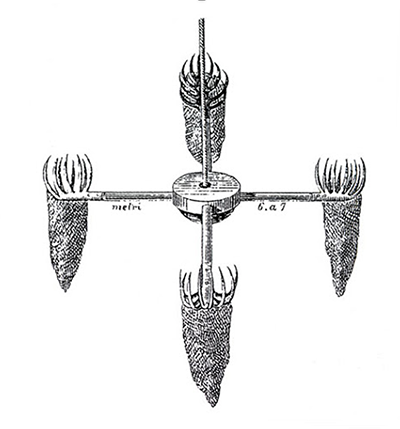 |
PIC. 14 – INGEGNO CHIARO (CLEAR DEVICE). It was formed by two wooden poles long from 6 to 7 meters for large boats, fixed as a cross as in the previous case and ballasted: in each extremity, iron raps with curved teeth were firmly inserted, equipped with a robust piece of net with impenetrable mesh to recover coral fragments detached from the raps action, falling into the collecting nets.
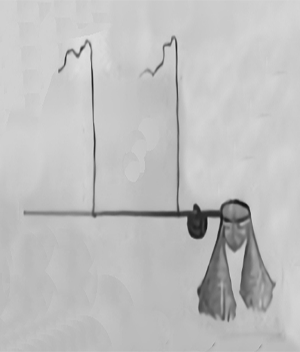 |
 |
PIC. 15a/15b - SALABRA OR SALABRE. It was a wooden ballasted beam, where at the end it was fixed a teethed ring on a net basket. It was operated from a boat with 2 long ropes tied just before their extremities, to be able to give them an oscillating movement. Especially useful to «scratch» walls and entrances of rock caves.
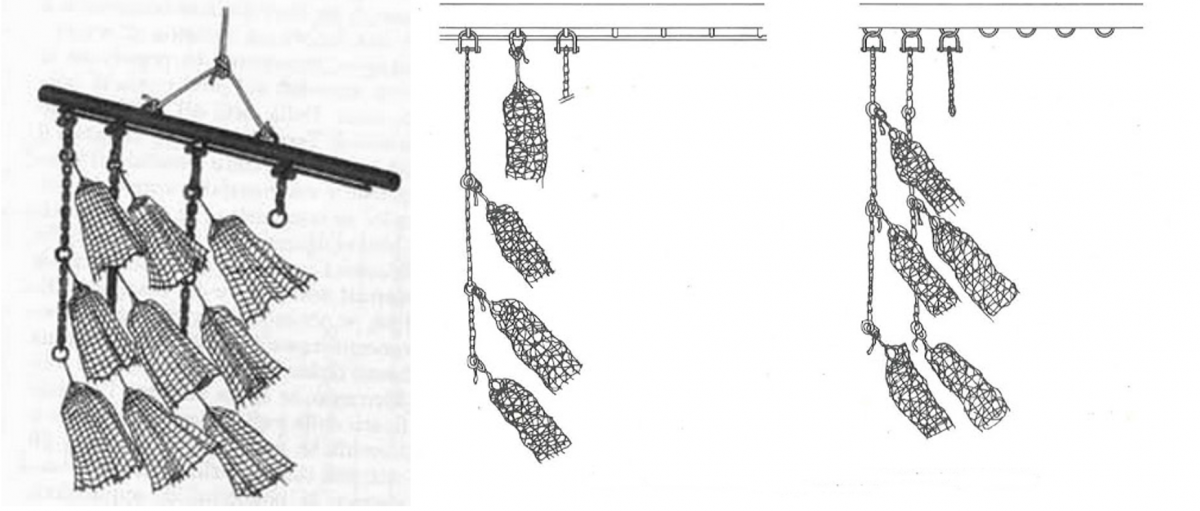 |
PIC. 16A/16B – ITALIAN BOARD. It was made with a wooden or metal board long several meters, ballasted with long handing chains, spaced out with net parts.
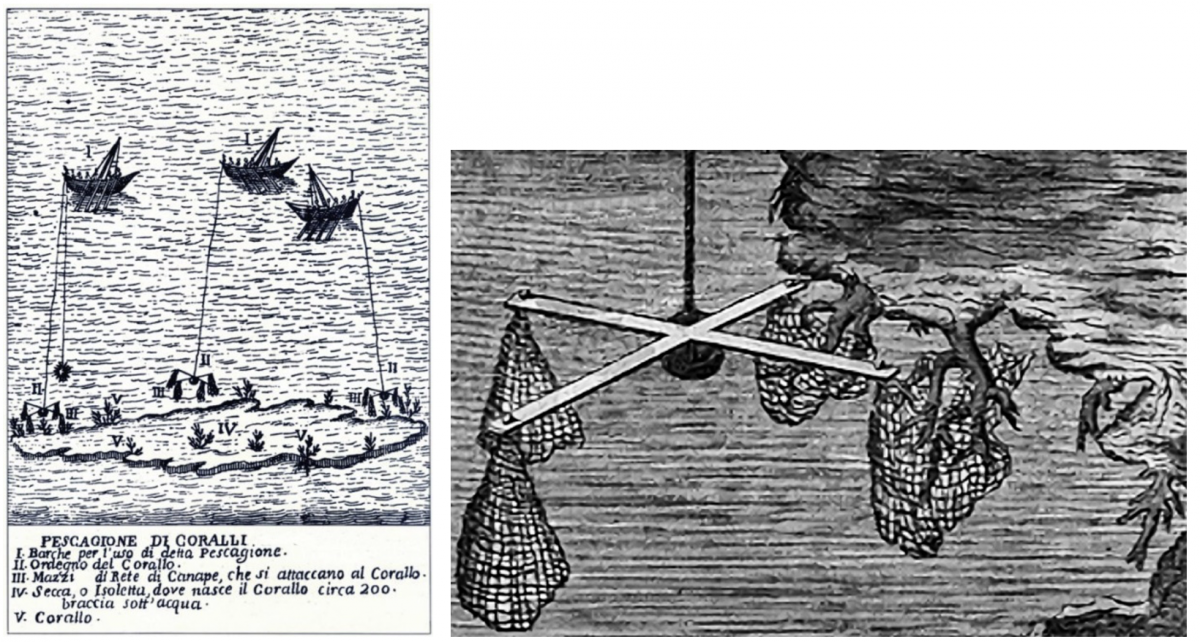 |
Pic. 17a/17b – Antique prints which show the device use
From the documentary film "Pericolo nelle Abissi" by Bruno Vailati - 1978
Pic. 18 – Coral fishermen working to recover coral from the device nets of the Italian board
______________________
